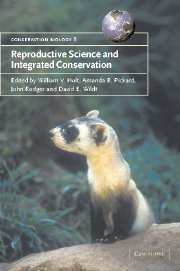Book contents
Part III - Reproductive techniques for conservation management
Published online by Cambridge University Press: 21 January 2010
Summary
An investment in knowledge pays the best interest.
Benjamin FranklinSince the early discovery that eggs could be fertilised in a laboratory Petri dish and that sperm and embryos could be frozen indefinitely, reproductive biologists have been passionate about using these tools in practical ways to produce offspring. Foremost has been the application to human infertility, now a well-recognised problem in adults of prime reproductive age. There now is a potpourri of options for correcting even the most serious cases of reproductive dysfunction. Spermatozoa can be used for artificial insemination, eggs can be recovered and fertilised in the laboratory, spermatozoa can be recovered from the epididymis or even from the testis and injected directly into the egg cytoplasm. As a last resort, couples can opt for donor semen, donor eggs, or even both. These advances have led to massive amounts of media attention and public discourse and have tended to create two serious misdirected impressions. The first is that it is the job of reproductive biologists to produce offspring using an ever increasingly bizarre menu of high-tech infertility ‘fixes’. And second, that the creation of life in a test tube is easy.
These notions have caused problems in the conservation community, the first being that traditional conservation biologists are often suspicious of high-tech fixes. Equally naïve managers and the public also often suppose that problems of breeding endangered species can be overcome simply by directly applying human infertility treatments.
- Type
- Chapter
- Information
- Reproductive Science and Integrated Conservation , pp. 129 - 131Publisher: Cambridge University PressPrint publication year: 2002

